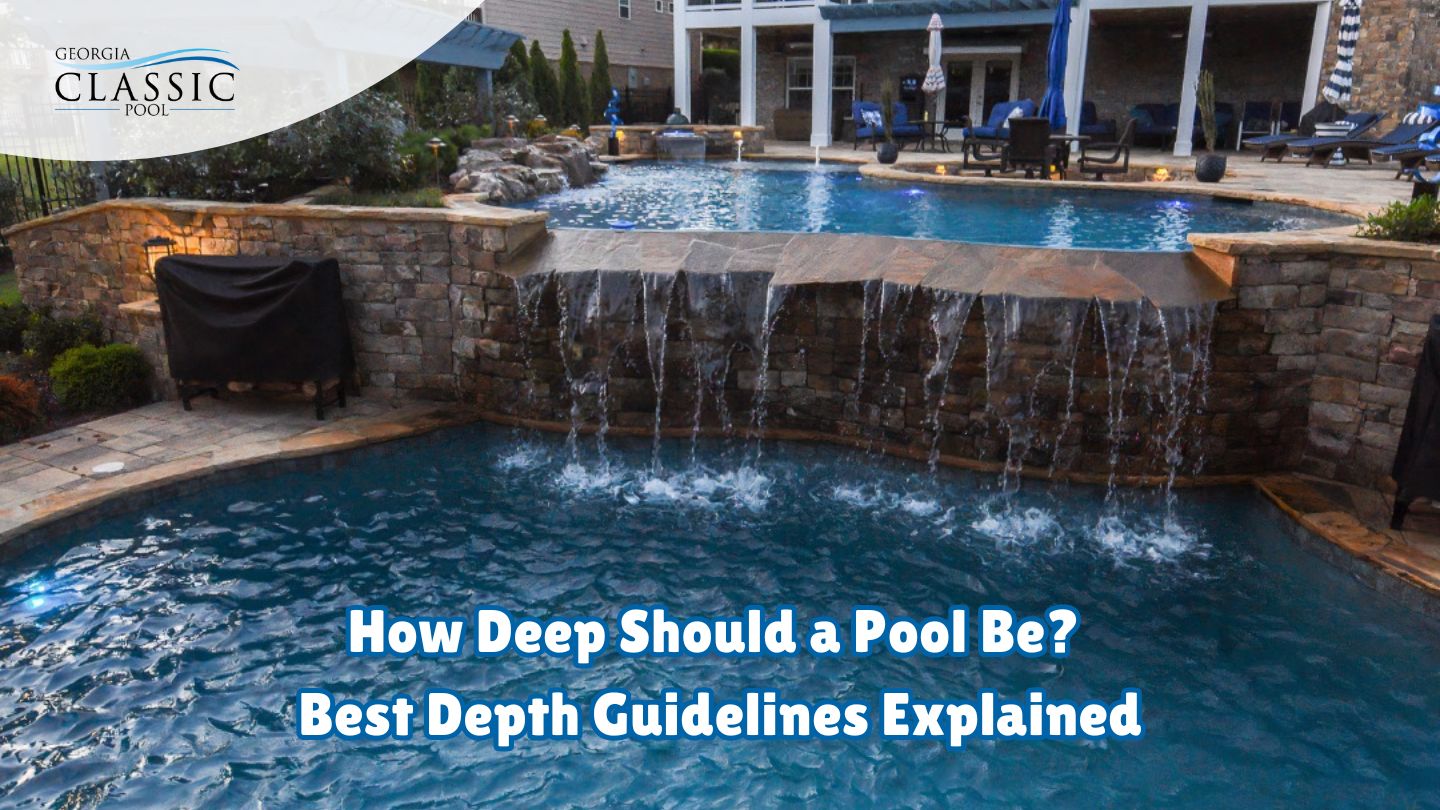Determining the ideal pool depth depends on how you plan to use it. Whether it’s for swimming laps, family enjoyment, diving, or relaxing, this guide offers the recommended depths for each activity, including the importance of an appropriate deep end for diving, to ensure both safety and fun when deciding how deep your pool should be.
Key Takeaways
- Choosing the correct pool depth depends on its purpose, user height, and safety considerations for both kids and adults.
- Multi-depth pools are great for accommodating different activities, combining shallow ends for relaxation and deeper areas for swimming and diving.
- A deep pool can significantly increase construction and maintenance costs, as it requires more excavation, uses more water, and necessitates higher long-term maintenance expenses. Budget considerations are, therefore, an essential factor in pool design.
Determining the Right Pool Depth
Selecting the correct pool depth is essential for a well-designed pool. The pool’s usage, user preferences, and safety need careful consideration. Safety is crucial; shallow pools can limit activities, while deep pools increase drowning risks. Striking a balance ensures maximum enjoyment.
Understanding the maximum pool depth is vital for safety, especially for children. While there are no strict laws, specific requirements exist for features like diving boards to ensure safety. Pool depth affects construction and maintenance costs, with deeper pools demanding more investment. Consulting experts ensure your pool design is functional and meets your needs.
Purpose of the Pool
The depth of your swimming pool is crucial for both safety and enjoyment. Whether you’re planning to swim laps, dive, or relax, the correct pool depth can enhance your experience. Here’s a quick guide to help you determine the ideal depth for your pool.
- Lap Swimming: A consistent depth of around four feet is ideal for swimming laps.
- Family Use: A minimum depth of three feet ensures safety and enjoyment for both kids and adults.
- Diving: At least eight feet of depth is necessary to prevent injuries for diving enthusiasts.
- Lounging: A depth of 3.5 to 4 feet offers comfort for lounging and cooling off.
Selecting the proper pool depth is vital to maximizing the fun and functionality of your swimming pool. By considering your specific needs and activities, you can create a perfect aquatic space that caters to everyone.
User Height Considerations
The height of individuals is a key factor in determining the depth of a pool. Pools with multiple depths usually provide comfort to most users when they have a depth range from 3 feet to 5 feet.
For couples that differ significantly in height, it’s advisable to take into account the shorter person’s stature while deciding on pool depth. Doing so will ensure both safety and pleasure for all users, eliminating any discomfort or potential hazards.
Recreational Swimming Pools
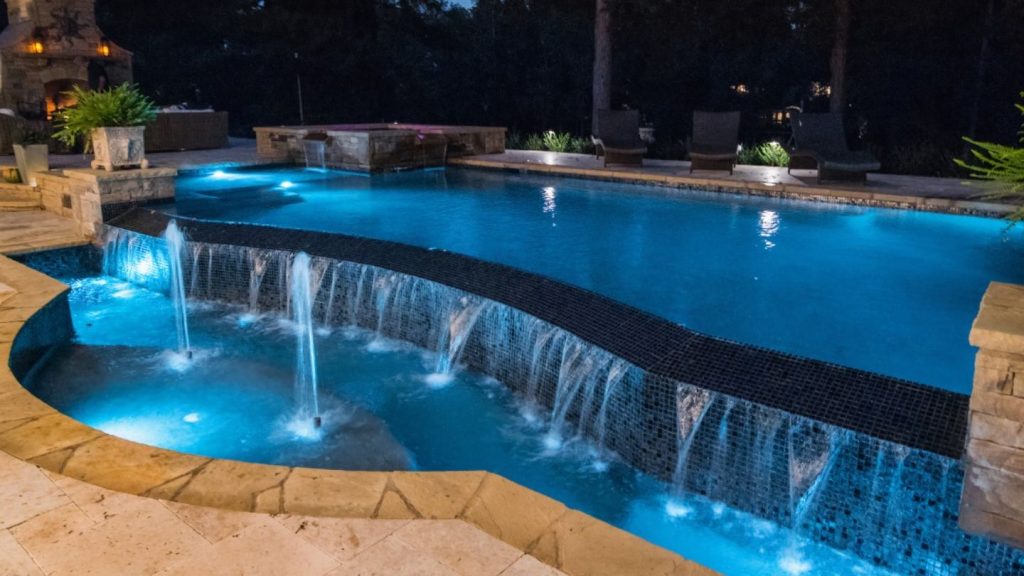
Recreational swimming pools, crafted for leisure and pleasure, usually have a depth that spans between 3 to 5 feet. To serve various swimmers’ needs safely and enjoyably, these pools are often segmented into different zones based on depth.
A thoughtfully designed recreational pool harmonizes the range of depths to accommodate users of all ages. From a shallow end suitable for children’s playtime to deeper areas intended for adult swimming activities, this diversity in-depth amplifies the swimming experience within these pools.
Moving forward, we will delve into the details concerning family-oriented pool sections and areas designated for relaxation.
Family Pools
Family pools need to cater to both children and adults, requiring depth flexibility. A minimum depth of three feet ensures a safe environment for kids and comfort for adults. For novice swimmers, depths between 1.2 to 1.8 meters offer safety and usability.
The shallow end of a family pool should be around 2.5 to 3.5 feet, with a gentle slope to deeper areas. This design enhances safety and allows for various activities, from wading to swimming laps. For very young children, separate wading pools or shallow zones are highly recommended.
Lounging and Cooling Off
A pool with a depth ranging from 3.5 to 4 feet is perfect for relaxing and staying cool, as it permits people to comfortably sit or stand in the water. Spaces that are extremely shallow, such as tanning ledges, which range from 0.75 to 1.5 feet deep, provide excellent places for soaking your feet and basking in the sunlight.
Adding shallow areas can significantly improve the use of a pool by providing various depths suitable for diverse activities. Incorporating sun shelves designed for children’s play or lounging sections intended for adults adds versatility and enhances the enjoyment of your pool.
Pools for Sports and Exercise
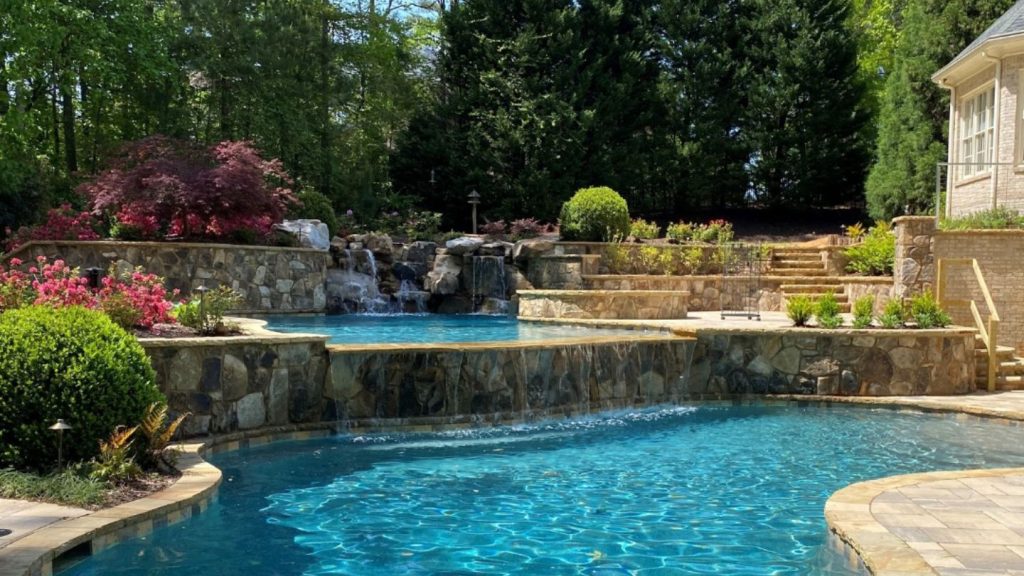
To ensure safety and optimal functionality, pools tailored for exercise and sports should adhere to certain pool depth specifications. For the purpose of preventing injuries while performing strokes, it is advised that pools intended for workouts maintain a depth of at least four feet throughout, facilitating diverse activities.
Choosing the correct pool depth plays a vital role when engaging in aquatic exercises such as swimming laps or water aerobics. This precision ensures both peak performance and safety within these environments.
Swimming Laps
For lap swimming, maintaining a pool depth of approximately four feet is optimal. It not only helps to prevent injuries when executing flip turns but also guarantees efficient exercise sessions. With this depth, swimmers can carry out their strokes without concern for colliding with the bottom of the pool.
Water Aerobics
For comfort and safety in water aerobics, the depth of the pool is critical. A three to five-foot pool depth permits participants to perform exercises with ease and without strain, ensuring movements are freely executed. The ideal situation is for water levels to reach from the belly button up to chest height for peak exercise performance.
The specified range of depth ensures there’s sufficient resistance for impactful workouts while simultaneously maintaining participant safety—a key component in reaping water aerobics’ rewards like better cardiovascular health and improved muscle tone.
Diving Pools
To guarantee the safety of divers, it is essential that diving pools have certain depths. The design includes deeper areas tailored to promote safe and injury-free diving experiences, providing a protective yet delightful setting for those engaged in diving.
It is imperative for diving aficionados to observe these established depth requirements carefully.
Safety Regulations
The depth of a diving pool is greatly affected by local regulations and insurance policies. It’s important to engage with a pool builder who can help you meet these legal stipulations and maintain safety protocols.
The choice to fit a diving board into your pool is subject to local codes, which also dictate the necessary depth for such an installation.
Multi-Depth Pools
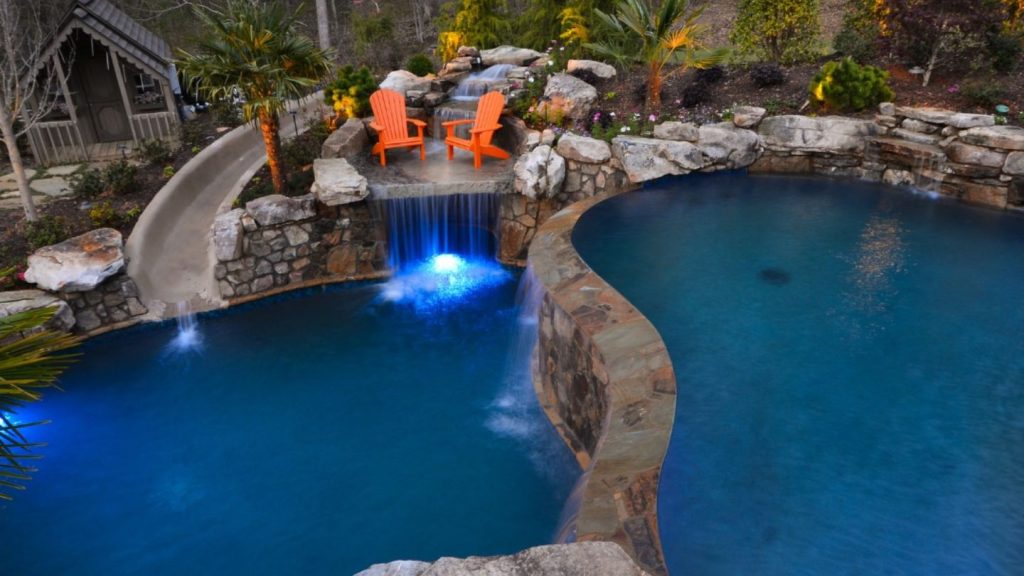
Multi-depth pools offer a versatile swimming experience, accommodating various activities and user preferences. They typically feature shallow ends for relaxation and deeper centers for swimming and diving, balancing fun and safety. This makes them ideal for families and recreational swimmers.
Multi-depth pools have unique features like shallow ends, deep centers, and L-shaped designs, including the option for a multiple-depth pool.
Shallow Ends and Deep Centers
Pools with multiple depth levels offer areas with shallow water for leisure, playtime for youngsters, and effortless access. Conversely, the deep central sections are ideal for activities such as swimming, diving into the depths, and other aquatic sports.
The gradual inclines in these pools serve to increase safety measures and make them more accessible. This versatility ensures that all users can enjoy their time in the pool safely.
L-Shaped Pools
L-shaped pools are an excellent swimming pool design choice for separating activity areas within the same L-shaped pool, enhancing usability and space. This design creates distinct zones, such as a shallow area for kids and a deeper section for swimming and diving, offering a versatile swimming experience.
Budget Considerations
Pool depth significantly influences construction costs, with deeper pools requiring more excavation and materials. These factors increase the overall cost and construction time, making deeper pools a more considerable investment. Maintenance costs are higher for deeper pools due to increased water volume and energy consumption.
Construction Costs
The construction of deeper pools incurs greater costs as a result of the need for more materials and prolonged excavation durations. The expenses associated with in-ground pools escalate according to their size and depth, representing a considerable monetary investment due to these extra expenditures.
Maintenance and Operation
Pools with greater depths necessitate additional energy for heating and filtering, which results in elevated ongoing expenditures. Due to the larger volume of water, there is a need for increased cleaning efforts and chemical maintenance, thereby driving up utility costs. The operational requirements associated with maintaining deeper pools contribute to their higher cost of upkeep as time progresses.
Child Safety in Pools
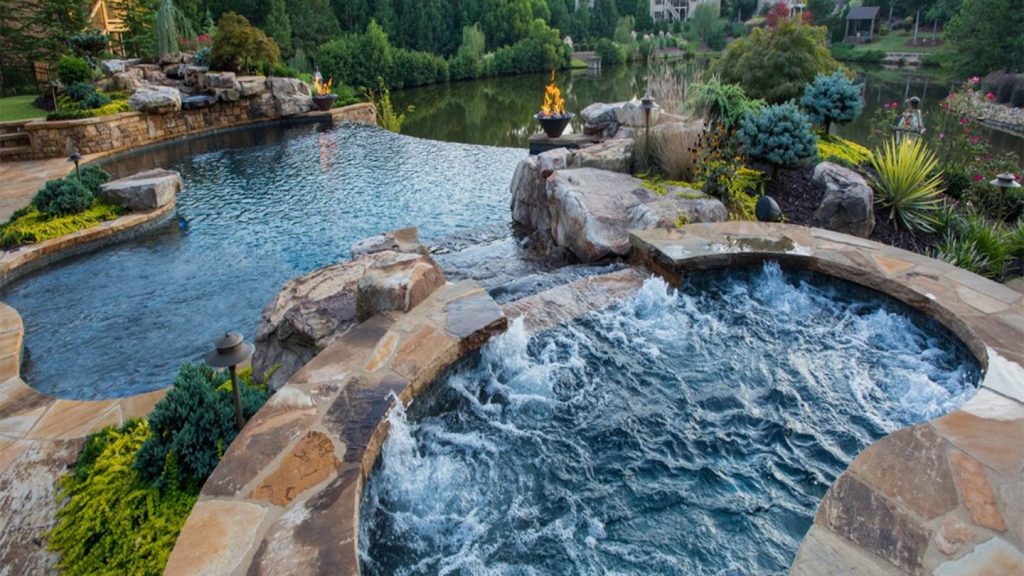
It is of utmost importance to prioritize child safety in pools. Pools with a flat bottom offer improved visibility and diminish the likelihood of injuries from diving. Conversely, shallow pools present dangers associated with diving, and deeper pools heighten the potential for drowning incidents involving children. It’s essential to create safety strategies that align with established standards for safe diving.
Incorporating particular elements and designs like wading sections and built-in safety features can significantly bolster child protection within pool areas.
Wading Areas
Pools designed with a separate wading pool or sun shelf that transitions from shallow to deeper areas are perfect for young toddlers, offering a secure play space. With an approximate depth of two feet, these pools create an optimal environment for the safety and enjoyment of little ones.
Incorporating features such as a sun shelf not only provides a dedicated safe zone for play but also boosts the safety measures near the entrance of the pool, ensuring greater protection for youngsters during their aquatic adventures.
Integrated Safety Features
Incorporating safety elements such as gentle inclines into pool designs is essential to minimize mishaps among children in pools with varying depths. Such features play a vital role in safeguarding younger swimmers and offer reassurance for guardians and parents.
Summary
To wrap up, determining the right pool depth is vital to ensure the enjoyment and safety of your swimming pool. Whether your pool is for leisure, sports, or safeguarding children, depth considerations are key to meeting its intended use. From shallow lounging areas to deep diving zones, the appropriate depth enhances the pool’s overall appeal.
Georgia Classic Pool is a distinguished name in the industry, known for its expertise in creating custom pools that cater to your unique requirements. With over two decades of experience in pool design and construction, we pride ourselves on delivering pools that are both aesthetically pleasing and functionally superior.
Choose Georgia Classic Pool to transform your backyard into a luxurious retreat. As the premier swimming pool builder in Atlanta, we are committed to realizing your vision and maximizing the potential of your outdoor space. Contact us today to start designing your dream pool and create the perfect oasis for relaxation and enjoyment.

